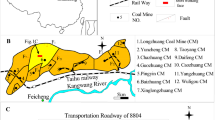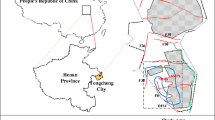Abstract
Karst water poses great menace to vast and extensive coal-bearing region in China. The large water bodies which are highly pressurized have caused appalling disasters. This study takes example from the North China coal-bearing region and introduces karst aquifer distribution. It points out the major contributors to karst water burst and its relation with bottom plate deformation under mining activities. The analysis of criteria to determine karst water burst focuses on two elements (water burst coefficient and critical water burst index) and their positive application in Huaibei Luling coalmine, North China coal-bearing region. All achievements can be of reference to other coal-producing countries which are confronted with karst water hazards.







Similar content being viewed by others
References
Bieniawski ZT (1982) Improved design of coal pillars for US mining conditions. In: proceedings of the first international conference on stability in underground mining, Vancouver, Canada, pp.16–18
Bieniawski ZT (1995) Design of mine pillars for long-term stability. In: proceedings of the international high-tech conference on geoengineering, national mining university of Beijing, China, 245–257 pp
Dong SN (2010) Integrated in-stu tests for water inrush possibility evaluation in coal seam floors. J Eng Geol 18(1):116–119
Fang PX, Wei ZD, Liao ZS (1987) Special hydrogeology. Geological Publishing House, Wuhan, pp 261–263
Gidley JL, Holditch SA, Nierode DE (1989) Recent advances in hydraulic fracture. Society petroleum engineering monograph, 119–204 pp
Gui HR, Gong QN, Sun BK (1999) Study of control theory on water inrush from bed bottom in deep mining-basic study thinking and plan. Journal of Huainan Institute of Technology 19(4):1–4
Gui HR, Lin ML (2016) Types of water hazards in China coalmines and regional characteristics. Nat Hazards 84(2):1501–1512
Gui HR, Lin ML, Song XM (2016) Technical research on controlling major karst water hazards in China coalmine. Water Practice and technology 11(3):661–671
Hayashi K, Sato A, Ito T (1997) In-site stress measurement by hydraulic fracturing for a rock mass with many planes of weakness. Int J Rock Mech Min Sci 34(1):45–48
Huang H, Li C (2008) Forecast method of water inrush of floor over confined water body and its prevention and control measures. Metal Mine 6:126–129
Jiang Q (2009) Coal floor strata failure depth test of working face at big mining depth. Coal Geology & Exploration 37(4):30–33
Kwasniewski M, Wang JA (1999) 3-D numerical modeling and study of mine termors associated with coal mining in the vicinity of major faults. Publs Inst Geophys POL ACAD SC M-22(310):351–364
Li BY, Shen GH, Jing ZG et al. (1987) Theory and practice to prevent water inrush in floor coal seam in mining panels. Conference proceeding of the 22nd international conference of mining safety, China coal industry publishing home, Beijing, 65–70 pp
Liu QM, Li WP, Ji ZK, Cheng W, Zeng XG, Jiao YL (2007) The method of actual measurement coefficient of water-resisting to evaluate dangerousness of Ordovician limestone water invasion. Coal Geology & Exploration 35(4):38–41
Liu QS, Liu KD (2012) Characteristics of in-situ stress field for deep levels in Huainan coalmine. Rock Soil Mech 33(7):2089–2096
Lu YL, Wang LG (2015) Numerical simulation of mining-induced fracture evolution and water flow in coal seam floor above a confined aquifer. Comput Geotech 67:157–171
Murdoch LC, Slack WW (2002) Forms of hydraulic fractures in shallow fine-grained formation. J Geotech Geoenviron 128(6):479–487
Qiu M, Shi LQ, Teng C, Xing TJ, Yu F (2015) Evaluation of water inrush risk for no.10 coal seam floor of Zhaoguan mine field. Coal Geology & Exploration 43(3):61–65
SACMS(State Administration of Coal Mine Safety) (2009) Regulations on coalmine water control. China Coal Industry Publishing Home, Beijing 83 pp
Sergio MR, Miguel RR, Francisco M et al (2009) Analysis of groundwater mining in two carbonate aquifers in sierra de Estepa (SE Spain) based on hydrodynamic and hydrochemical data. Hydrogeol J 17:1617–1627
Sui WH, Liu JY, Yang SG et al (2011) Hydrogeological analysis and salvage of a deep coalmine after a groundwater inrush. Environmental Earth Sciences 62(4):735–749
Sun WJ, Wu Q, Liu HL et al (2015) Prediction and assessment of the disturbances of the coal mining in Kailuan to karst groundwater system. Phys Chem Earth 89-90:136–144
Vutukuri VS, Singh RN (1995) Mine inundation-case histories. Mine Water and the Engineering 14(9):107–130
Wang MJ (2015) In-site measurement and physical analogue on water inrush from coal floor induced by progressive intrusion of artesian water into protective aquiclude. Chinese Journal of Geotechnical Engineering 21(5):546–549
Wang JA, Park HD (2003) Coal mining above a confined aquifer. Int J Rock Mech Min Sci 40(4):537–551
Wu Q, Pang W, Dai YC, Yu J (2006) Vulnerability forecasting model based on coupling technique of GIS and ANN in floor groundwater bursting. J China Coal Soc 31(3):314–319
Wu Q, Xu H, Zhou WF (2008) Development of a 3D GIS and its application to karst areas. Environ Geol 54(5):1037–1045
Wu Q, Zhang ZL, Zhang SY, Ma JF (2007) A new practical methodology of the coal floor water bursting evaluating II: the vulnerable index method. J China Coal Soc 32(11):1122–1126
Wu Q, Zhao SQ, Dong SN et al (2013) Handbook to coalmine water control. China Coal Industry Publishing Home, Beijing, pp 28–40
Wu Q, Zhou WF, Pan GY et al (2009) Application of a discrete-continuum model to karst aquifers in North China. Groundwater 47(3):453–461
Xie XH, Su BY, Gao XF, Duan XB (2009) Numerical study on water inrush above a confined aquifer in coal mining using hydro-fracturing. Chin J Rock Mech Eng 24(6):987–993
Xu YC, Li JH, Liu BZ (2014) Reinforcement of working face by grouting in floor in Jiaozuo coal mining area. Coal Geology & Exploration 42(4):50–54
Xu FT, Xie L, Zhang NH, Zhang HW (2015) Studies on acoustic emission characteristics of sandstone under uniaxial compression. China Mining Magazine 24(6):147–150
Yin SX, Hu WY (2008) Rocks’water-resistance ability and natural progressive intrusion height. Coal Geology & Exploration 36(1):35–40
Zeng YF, Wu Q, Liu SQ et al (2016) Vulnerability assessment of water bursting from Ordovician limestone into coal mines of China. Environmental Earth Sciences 75(22):1431 (1-11)
Zhang JC (2005) Investigation of water inrush from aquifers under coal seams. Int J Rock Mech Min Sci 42(3):350–360
Zhang R, Jiang ZQ, Zhou HY et al (2014) Groundwater outbursts from faults above a confined aquifer in the coalmining. Nat Hazards 71(3):1861–1872
Zheng F, Wang LB, Zhu QX et al (2015) Simulation research on failure depth and stress distribution of coal seam floor based on FLAC3D.Coal. Technology 34(2):106–108
Acknowledgement
This article is funded by the National Natural Science Foundation of China (41373095), University Natural Science Research Project of Anhui Province (KJ2017A445) and Anhui Science and Technology Breakthrough Project (1501zc04048).
Author information
Authors and Affiliations
Corresponding author
Rights and permissions
About this article
Cite this article
Gui, H., Song, X. & Lin, M. Water-inrush mechanism research mining above karst confined aquifer and applications in North China coalmines. Arab J Geosci 10, 180 (2017). https://doi.org/10.1007/s12517-017-2965-5
Received:
Accepted:
Published:
DOI: https://doi.org/10.1007/s12517-017-2965-5




